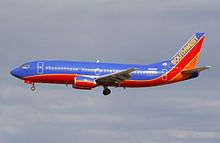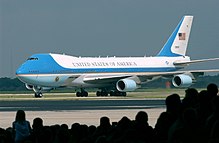Aircraft livery
This article needs additional citations for verification. (July 2007) |


Aircraft livery is a paint scheme applied to an aircraft, generally to fuselage, wings, empennage (tail fin), or jet engines. Most airlines have a standard paint scheme for their aircraft fleet, usually prominently displaying the airline logo or name. From time to time special liveries are introduced, for example prior to big events. The term is derived from the more general term livery.
Types
Airline Liveries
Standard Airline Liveries
Bare metal

Bare metal aircraft liveries are somewhat ubiquitous with the advances to aircraft technology during the 1930's and the tremendous sales success of the Douglas DC 3. What has often been called one of the first modern airliners which could actually turn a meaningful profit for the airlines, the Douglas DC3's sleek and shiny aluminum fuselage wings and body, represented the latest in streamlining aircraft for increased speeds. This at a time when many aircraft were still fabricated out of wood and canvas. Correspondingly, companies like Eastern Air Lines, Delta Air Lines, and American Airlines (now very well known for its distinctive bare-metal liveries) chose to leave their aircraft unpainted as a clear sign they operated the speediest most up to date fleets. During more recent times others such as Air Canada, US Airways, Western Airlines, Pan Am, Aeromexico, Jat Airways, Northwest Airlines and Cathay Pacific also maintained unpainted airplanes along significant portions of their histories.
Among some advantages of not painting aircraft surfaces, this type of paint scheme reduces weight and therefore results in fuel savings; however, some analysts estimate that the extra cost to maintain and polish a bare metal scheme outweighs the fuel saving benefits.[1]

Cheatline
A cheatline is decorative, horizontal, single or multiple, bands of color applied to both sides of a fuselage. Historically, the cheatline was located at or just below an aircraft's window line. However, in more recent times the cheatline has migrated and increasingly has become less laterally based.

Billboard

With the introduction of widebody aircraft, a new form of livery also came about called the billboard livery. With billboard liveries the actual name of the airline became the unique and main feature of an airlines fuselage livery. By abandoning the cheatline that had traditionally run the length of the aircraft along the windowline; billboard liveries dropped the window cheatline colours and extended the name of the airlines titles above as well as below the window line in a much larger script. Among some of the airline pioneers who adopted this style of airline livery, were Union de Transports Aériens (UTA) and Pan Am along with AVENSA. Other notable airlines who dropped the traditional cheatline earlier than others, were [[Hughes Airwest]] after the [[Hughes Airwest flight 706]] disaster and those that adopted billboard titles upon solid colored fuselages, such as Braniff with their 747SPs, and Muse Air along their McDonnell Douglas aircraft In recent years, two of the three main Airline alliances have uniquely adopted billboard titling for their advertising branding and joint airline liveries.
Jelly Bean / Jelly Tail

The most notable Jelly Bean livery used among North America airlines is the design concept introduced by Braniff International Airlines in November 1965, as part of their "End of the Plain Plane" campaign: there were 7 different, solid-colored schemes featuring pastel colors on the fuselage, white wings and tail, and formal black titles and nose.
A slight variant of the "Jelly Bean" concept is the Jelly Tails of JetBlue Airways, Mexicana, Frontier Airlines, and Air-India Express. These liveries are characterized by the vertical stabilizer and sometimes aft fuselage being painted in multiple designs, as is the case with British Airways' short lived Newell and Sorrell World Tails design. PLUNA of Uruguay is one of the most recent airlines to adopt this attractive and colorful corporate imagery.
Specialized Airline Liveries
Heritage
Heritage livery is a livery that an airline has used in the past (apart from any modern livery used by an airline).
Commemorative

Commemorative liveries are one off paint schemes applied by airlines to celebrate a milestone in their history. One such example would be ATA Airlines 25th anniversary paint scheme, celebrating the airline's inception under George Mikelson, the founder of American Trans Air,[2] or SkyWest Airlines paint scheme used to commemorate 30th anniversary of that airline.
Logo
Airlines often apply and paint specialized liveries to their standard airline liveries and logos of their aircraft, examples being:
- the logo of a sports team
- images of a city, usually a hub or other city of importance to the airline
- advertising for a company (logojet)
Southwest Airlines is famous for its various liveries promoting Sea World (painted to resemble an Orca), various US states where Southwest has operations (painted to resemble the states' flags), and other entities such as the NBA and the Ronald McDonald House.
Airline Alliance Liveries
Three multinational worldwide airline alliances have grown and developed their own aircraft liveries and corporate identity which encompass and transcend major carriers, mainline carriers, legacy carriers and flag airlines individual airline identities along with any ties to regional, geopolitical, national boundaries, and government heritages.
Oneworld, SkyTeam, and Star Alliance are the mutually agreed upon "airline alliance liveries" of large numbers of independent and separately owned airlines working together as one through a system of codeshare agreements, rather than the colors of any one certificated airline.
Unlike the other airline alliance consortium members, Oneworld will retain the "jellytail" airline logo markings of their individual airline alliance partner members upon each member airlines vertical stabilizer.
Non Airline Liveries
Government

Air transports of heads of state and government are often painted in unique colour schemes. The US President's aircraft, Air Force One, uses a light-blue and sky-blue color scheme, with the Seal of the President of the United States just above front gear and the flag of the United States on the tailfin designed by French-American industrial designer Raymond Loewy.[3]
An aircraft used to transport state or government leaders is often painted in a livery that represents national colors of a country or colors of a particular government office, and most of the time is coordinated with flag, seal and other insignia.
Military

Military aircraft often make use of aircraft camouflage to make the aircraft more difficult to see in the air and on the ground. This form of camouflage makes use of light and color patterns, and is dependent upon environmental conditions and is mainly effective against human observers, though some electronic visual acquisition systems can be affected. Visual camouflage does not protect an aircraft against radar location or heat-seeking electronics.
Since the release of MIL-STD-2161,[4] the Navy's tactical aircraft use a color scheme designed to reduce visual detection that consists of shades of flat gray with exterior markings applied in a contrasting shade of gray. Note that the stated purpose of this document is to standardize paint schemes and application of naval insignia and markings.
Aircraft camouflage was first used during World War I and was employed extensively during the first half of World War II. After radar detection systems were developed, aircraft camouflage became less important to the Allies, and a number of late-war Allied aircraft were brought to battle with no camouflage. Subsequent camouflage schemes, when used, concentrated on hiding the aircraft from aerial observation while it was resting on or flying near the ground, or they used a light, neutral color to inhibit detection while in the air. Modern camouflage schemes have experimented with light-emitting active camouflage systems which seek to conceal the aircraft from human vision or to blur or confuse optical observation by electronic means.[5]
See also
- Airline liveries and logos
- Livery
- Nose art
- Roundel
- Heritage aircraft
- Logojet
- US Airways livery
- Pokémon Jet
References
- ^ http://www.boeing.com/commercial/aeromagazine/aero_05/textonly/fo01txt.html
- ^ N772AT Priceless Memories
- ^ Walsh, Kenneth T. Air Force One: A History of the Presidents and Their Planes. New York: Hyperion: 2003. ISBN 1-4013-0004-9.
- ^ "MIL-STD-2161A, Department of Defense Standard Practice: Paint Schemes and Markings for U.S. Navy and Marine Corp Aircraft" (PDF). United States Navy. 1 May 1993.
- ^ Shaw, Robert (1985). Fighter combat: tactics and maneuvering. Naval Institute Press. p. 55. ISBN 0-87021-059-9.



